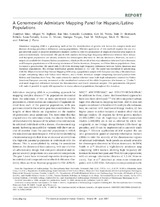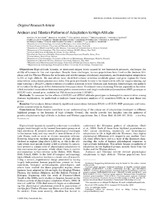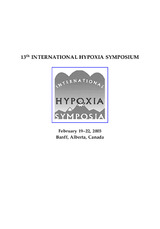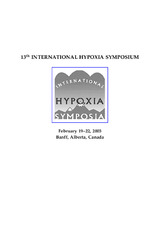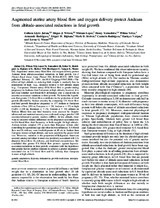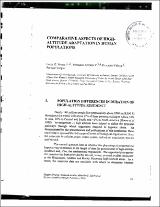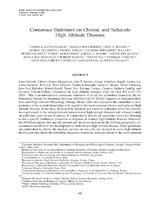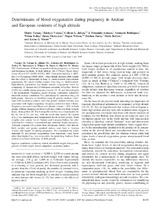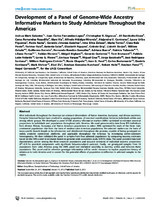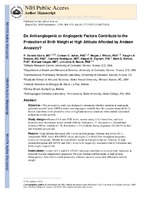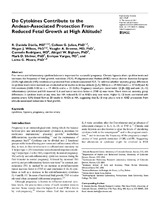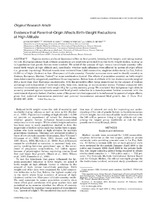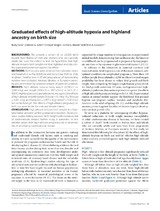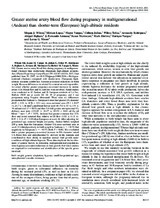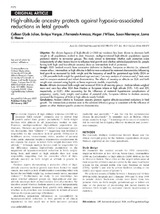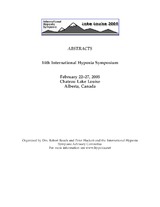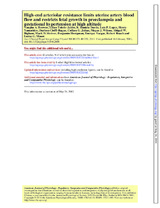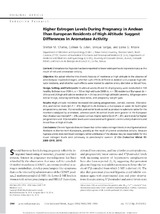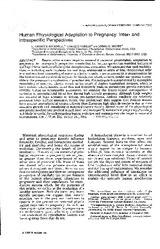Listar por autor "Moore, Lorna G"
Mostrando ítems 1-20 de 39
-
A genomewide admixture mapping panel for hispanic/latino populations
Xianyun, Mao; Bigham, Abigail W; Mei, Rui; Gutiérrez, Gerardo; Weiss, Ken M; Brutsaert, Tom D; León-Velarde, Fabiola; Moore, Lorna G; Vargas, Enrique; McKeigue, Paul M; Shriver, Mark D; Parra, Esteban J (The American Journal of Human Genetics, 2007-06)Admixture mapping (AM) is a promising method for the identification of genetic risk factors for complex traits and diseases showing prevalence differences among populations. Efficient application of this method requires the ... -
Andean and Tibetan patterns of adaptation to high altitude
Bigham, Abigail W; Wilson, Megan J; Julian, Colleen Glyde; Kiyamu, Melisa; Vargas, Enrique; León-Velarde, Fabiola; Rivera-Chira, María; Rodríguez, Carmelo; Browne, Vaughn A.; Parra, Esteban; Brutsaert, Tom D; Moore, Lorna G; Shriver, Mark D (American Journal of Human Biology, 2013-01-24)Objectives: High-altitude hypoxia, or decreased oxygen levels caused by low barometric pressure, challenges the ability of humans to live and reproduce. Despite these challenges, human populations have lived on the Andean ... -
Andean compared with european women are protected from altitude-associated intrauterine growth restriction (IUGR)
Moore, Lorna G; Armaza, Fernando; Keyes, L; Borth, R; Niermeyer, Susan; Villena, Mercedes; MacCannell, Wendy; Vargas, Enrique (s.n., 2003)Abstract. Babies born at high altitude to long-term high-altitude residents weigh more than those of recent migrants from low altitude. Objective: We asked whether a gradient exists such that persons of Andean ancestry ... -
Andean women have greater uterine artery (UTA) enlargement during pregnancy than european residents of 3600 m.
Moore, Lorna G; Wilson, Megan; López, Miriam; Vargas, Marco; Parra, Esteban; Niermeyer, Susan; Aramaza, J Fernando; Vargas, Enrique ([s.n.], 2003)Abstract. Babies weigh less at high altitude but multi-generational high-altitude residents are protected from this birth weight decline (Moore HAMB 2001). Objective: We asked if higher arterial oxygenation and/or blood ... -
Augmented uterine artery blood flow and oxygen delivery protect andeans from altitude-associated reductions in fetal growth
Julian, Colleen Glyde; Wilson, Megan J; López, Miriam; Yamashiro, Henry; Téllez, Wilma; Rodríguez, Armando; Bigham, Abigail W; Shriver, Mark D; Rodríguez, Carmelo; Vargas, Enrique; Moore, Lorna G (Am J Physiol Regul Integr Comp Physiol, 2009-02-20)Abstract. The effect of high altitude on reducing birth weight is markedly less in populations of high- (e.g., Andeans) relative to low-altitude origin (e.g., Europeans). Uterine artery (UA) blood flow is greater ... -
Comparative aspects of high-altitude adaptation in human populations
Moore, Lorna G; Armaza, Fernando; Villena, Mercedes; Vargas, Enrique (Adv. Exp. Med. Biol., 2000)Abstract. The conditions and duration of high-altitude residence differ among high-altitude populations. The Tibetan Plateau is larger, more geographically remote, and appears to have been occupied for a longer period of ... -
Consensus statement on chronic and subacute high altitude diseases
León-Velarde, Fabiola; Maggiorini, Marco; Reeves, John T; Aldashev, Almaz; Asmus, Ingrid; Bernardi, Luciano; Ge, Ri-Li; Hackett, Peter; Kobayashi, Toshio; Moore, Lorna G; Peñaloza, Dante; Richalet, Jean-Paul; Roach, Robert; Wu, Tianyi; Vargas, Enrique; Zubieta-Castillo, Gustavo; Zubieta-Calleja, Gustavo (High Altitude Medicine & Biology, 2005)ABSTRACT. This is an international consensus statement of an ad hoc committee formed by the In ternational Society for Mountain Medicine (ISMM) at the VI World Congress on Mountain Med icine and High Altitude Physiology ... -
Determinants of blood oxygenation during pregnancy in Andean and Europeas residents of high altitude
Vargas, Marco; Vargas, Enrique; Julian, Colleen Glyde; Armaza, J Fernando; Rodríguez, Armando; Téllez, Wilma; Niermeyer, Susan; Wilson, Megan; Parra, Esteban; Shriver, Mark; Moore, Lorna G (Am J Physiol Regul Integr Comp Physiol, 2007-07-02)High altitude decreases birth weight, but this effect is diminished in long vs. short-resident, high-altitude populations. We asked whether women from long vs. short-resident, high-altitude populations had higher arterial ... -
Development of a panel of genome-wide ancestry informative markers to study admixture throughout the Americas
Galanter, Joshua Mark; Fernández-López, Juan Carlos; Gignoux, Christopher R.; Barnholtz-Sloan, Jill; Fernández-Rozadilla, Ceres; Via, Marc; Hidalgo-Miranda, Alfredo; Contreras, Alejandra V; Uribe Figueroa, Laura; Raska, Paola; Jiménez-Sánchez, Gerardo; Silva Zolezzi, Irma; Torres, María; Ruiz Ponte, Clara; Ruiz, Yarimar; Salas, Antonio; Nguyen, Elizabeth; Eng, Celeste; Borjas, Lisbeth; Zabala, William; Barreto, Guillermo; Rondón González, Fernando; Ibarra, Adriana; Taboada, Patricia; Porras, Liliana; Moreno, Fabián; Bigham, Abigail; Gutiérrez, Gerardo; Brutsaert, Tom; León-Velarde, Fabiola; Moore, Lorna G; Vargas, Enrique; Cruz, Miguel; Escobedo, Jorge; Rodríguez-Santana, José; Rodríguez-Cintrón, William; Chapela, Rocio; Ford, Jean G; Bustamante, Carlos; Seminara, Daniela; Shriver, Mark; Ziv, Elad; Gonzalez Burchard, Esteban; Haile, Robert; Parra, Esteban; Carracedo, Ángel (PLOS Genetics, 2012-03-08)Abstract. Most individuals throughout the Americas are admixed descendants of Native American, European, and African ancestors. Complex historical factors have resulted in varying proportions of ancestral contributions ... -
Do anti-angiogenic or angiogenic factors contribute to the protection of birth weight at high altitude afforded by andean ancestry?
Dávila, R Daniela; Julian, Colleen Glyde; Wilson, Megan J; Browne, Vaughn A.; Rodríguez, Carmelo; Bigham, Abigail W; Shriver, Mark D; Vargas, Enrique; Moore, Lorna G (Reprod Sci., 2010-09)Abstract. Objective: This prospective study was designed to determine whether variation in angiogenic (placental growth factor [PlGF]) and/or anti-angiogenic (soluble fms-like tyrosine kinase [sFlt-1]) factors contribute ... -
Do cytokines contribute to the andean-associated protection from reduced fetal growth at high altitude?
Dávila, R Daniela; Julian, Colleen Glyde; Wilson, Megan J; Browne, Vaughn A; Rodríguez, Carmelo; Bigham, Abigail W; Shriver, Mark D; Vargas, Enrique; Moore, Lorna G (Reproductive Sciences, 2011)Abstract. Pro- versus anti-inflammatory cytokine balance is important for successful pregnancy. Chronic hypoxia alters cytokine levels and increases the frequency of fetal growth restriction (FGR). Multigenerational Andean ... -
Does chronic mountain sickness (CMS) have perinatal origins?
Moore, Lorna G; Niermeyer, Susan; Vargas, Enrique (Respiratory Physiology & Neurobiology, 2007-06-29)Abstract. Chronic mountain sickness (CMS) occurs in 10% of male high-altitude residents. It is characterized by hypoventilation and hypoxemia but its underlying cause remains unknown. We hypothesized that CMS' origins ... -
Evidence that parent-of-origin affects birth-weight reductions at high altitude
Bennett, Adam; Sain, Stephen R; Vargas, Enrique; Moore, Lorna G (American Journal of Human Biology, 2008-02-19)Abstract. Hypoxia exerts a profound depressant effect on fetal growth, lowering birth weight, and raising mortality risk. Multigenerational high-altitude populations are relatively protected from this birth-weight decline, ... -
Graduated effects of high-altitude hypoxia and highland ancestry on birth size
Soria, Rudy; Julian, Colleen Glyde; Vargas, Enrique; Moore, Lorna G; Giussani, Dino A (Pediatric Research, 2013-10-02)Background: We present a cohort of ca. 25,000 birth records from Bolivia of men and women who are currently adults. We used this cohort to test the hypothesis that high altitude reduces birth weight and that highland ... -
Greater uterine artery blood flow during pregnancy in multigenerational (Andean) than shorter-term (European) high-altitude residents
Wilson, Megan J; López, Miriam; Vargas, Marco; Julian, Colleen Glyde; Téllez, Wilma; Rodríguez, Armando; Bigham, Abigail; Armaza, J Fernando; Niermeyer, Susan; Shriver, Mark; Vargas, Enrique; Moore, Lorna G (Am J Physiol Regul Integr Comp Physiol, 2007)Multigenerational (Andean) compared with shorter-term (European) high-altitude residents exhibit less hypoxia-associated reductions in birth weight. Because differences in arterial O2 content are not responsible, we ... -
High-altitude ancestry protects against hypoxia-associated reductions in fetal growth
Julian, Colleen Glyde; Vargas, Enrique; Armaza, J Fernando; Wilson, Megan J; Niermeyer, Susan; Moore, Lorna G (Archives of Disease in Childhood-Fetal and Neonatal, 2007-02-28)Objective: The chronic hypoxia of high-altitude (>2500 m) residence has been shown to decrease birth weight in all populations studied to date. However, multigenerational high-altitude populations appear protected relative ... -
High-altitude ancestry protects against IUGR and reductions in birth weight associated with high altitude and preeclampsia
Julian, Colleen Glyde; Vargas, Enrique; MacCannell, Wendy; Armaza, Fernando; Moore, Lorna G (High Altitude Medicine & Biology, 2005-02-22)Background. Observations consistently demonstrate diminished birth weight [BW] with ascending altitude; however population comparisons reveal the extent of BW reduction depends, in part, upon high-altitude ancestry. ... -
High-end arteriolar resistance limits uterine artery blood flow and restricts fetal growth in preeclampsia and gestational hypertension at high altitude
Browne, Vaughn A; Toledo-Jaldín, Lilian; Dávila, R Daniela; López, Luis P; Yamashiro, Henry; Cioffi-Ragan, Darleen; Julian, Colleen Glyde; Wilson, Megan J; Bigham, Abigail W; Shriver, Mark D; Honigman, Benjamín; Vargas, Enrique; Roach, Robert; Moore, Lorna G (Am J Physiol Regul Integr Comp Physiol, 2011)The reduction in infant birth weight and increased frequency of preeclampsia (PE) in high-altitude residents have been attributed to greater placental hypoxia, smaller uterine artery (UA) diameter, and lower UA blood ... -
Higher estrogen levels during pregnancy in Andean than European residents of high altitude suggest differences in aromatase activity
Charles, Shelton M; Julian, Colleen Glyde; Vargas, Enrique; Moore, Lorna G (J Clin Endocrinol Metab, 2014-08)Context: Uteroplacental hypoxia has been reported to lower estrogen levels in preeclampsia as the result of reduced aromatase activity. Objective: We asked whether the chronic hypoxia of residence at high altitude in the ... -
Human physiological adaptation to pregnancy : inter- and intrspecific perspectives
Rockwell, Christie; Vargas, Enrique; Moore, Lorna G (American Journal of Human Biology, 2003)Abstract. Reproductive success requires successful maternal physiological adaptation to pregnancy. An interspecific perspective reveals that the human species has modified features of our haplorhine heritage affecting ...

